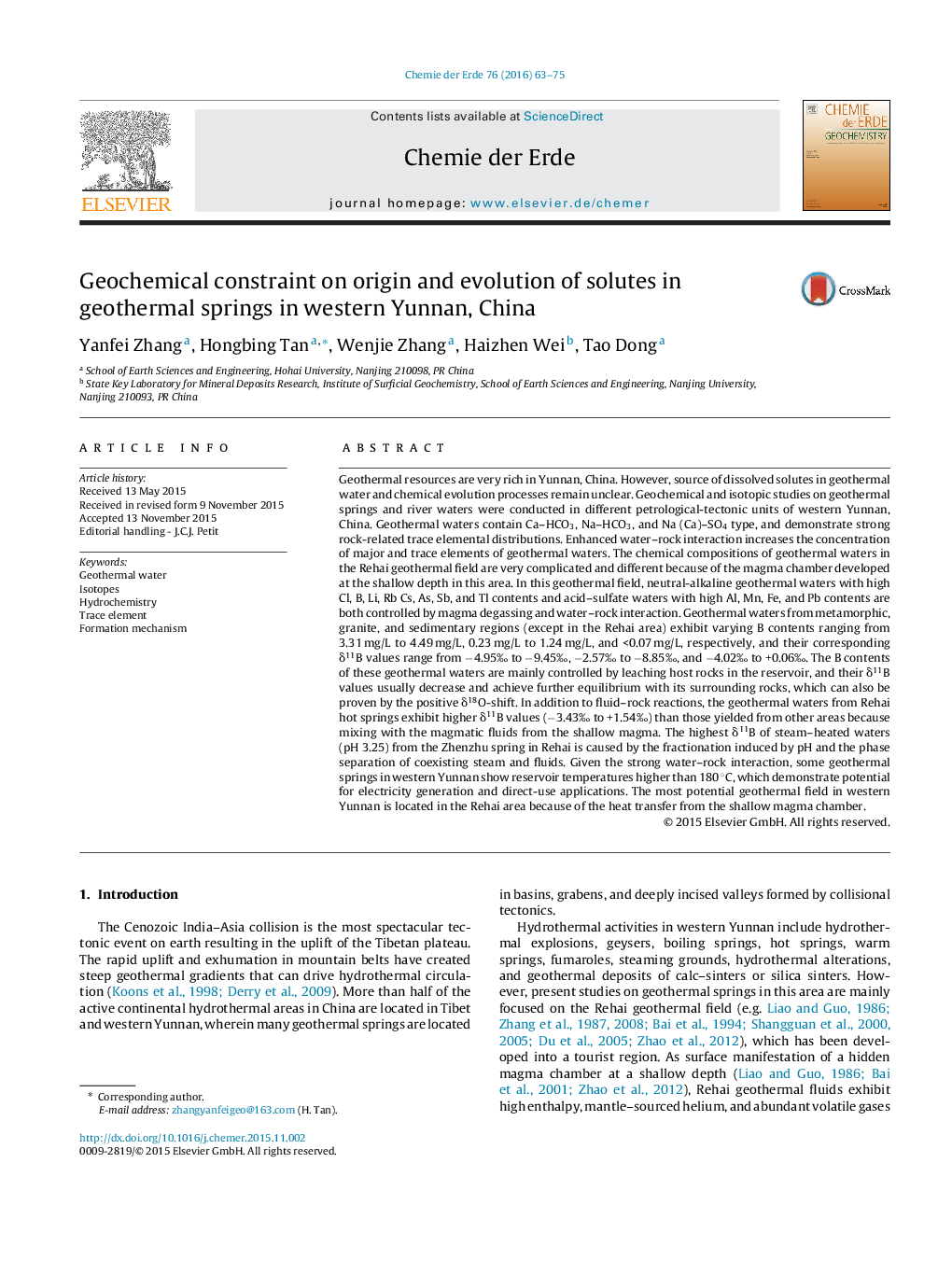| کد مقاله | کد نشریه | سال انتشار | مقاله انگلیسی | نسخه تمام متن |
|---|---|---|---|---|
| 4406793 | 1307320 | 2016 | 13 صفحه PDF | دانلود رایگان |
عنوان انگلیسی مقاله ISI
Geochemical constraint on origin and evolution of solutes in geothermal springs in western Yunnan, China
ترجمه فارسی عنوان
محدودیت ژئوشیمیایی در مبدا و تکامل حلالها در چشمه های زمین گرمایی در غرب یونان، چین
دانلود مقاله + سفارش ترجمه
دانلود مقاله ISI انگلیسی
رایگان برای ایرانیان
کلمات کلیدی
آب ژئوترمال، ایزوتوپها، هیدرو کیمیا، عنصر ردیابی، مکانیزم تشکیل
موضوعات مرتبط
مهندسی و علوم پایه
علوم زمین و سیارات
ژئوشیمی و پترولوژی
چکیده انگلیسی
Geothermal resources are very rich in Yunnan, China. However, source of dissolved solutes in geothermal water and chemical evolution processes remain unclear. Geochemical and isotopic studies on geothermal springs and river waters were conducted in different petrological-tectonic units of western Yunnan, China. Geothermal waters contain Ca-HCO3, Na-HCO3, and Na (Ca)-SO4 type, and demonstrate strong rock-related trace elemental distributions. Enhanced water-rock interaction increases the concentration of major and trace elements of geothermal waters. The chemical compositions of geothermal waters in the Rehai geothermal field are very complicated and different because of the magma chamber developed at the shallow depth in this area. In this geothermal field, neutral-alkaline geothermal waters with high Cl, B, Li, Rb Cs, As, Sb, and Tl contents and acid-sulfate waters with high Al, Mn, Fe, and Pb contents are both controlled by magma degassing and water-rock interaction. Geothermal waters from metamorphic, granite, and sedimentary regions (except in the Rehai area) exhibit varying B contents ranging from 3.31 mg/L to 4.49 mg/L, 0.23 mg/L to 1.24 mg/L, and <0.07 mg/L, respectively, and their corresponding δ11B values range from â4.95â° to â9.45â°, â2.57â° to â8.85â°, and â4.02â° to +0.06â°. The B contents of these geothermal waters are mainly controlled by leaching host rocks in the reservoir, and their δ11B values usually decrease and achieve further equilibrium with its surrounding rocks, which can also be proven by the positive δ18O-shift. In addition to fluid-rock reactions, the geothermal waters from Rehai hot springs exhibit higher δ11B values (â3.43â° to +1.54â°) than those yielded from other areas because mixing with the magmatic fluids from the shallow magma. The highest δ11B of steam-heated waters (pH 3.25) from the Zhenzhu spring in Rehai is caused by the fractionation induced by pH and the phase separation of coexisting steam and fluids. Given the strong water-rock interaction, some geothermal springs in western Yunnan show reservoir temperatures higher than 180 °C, which demonstrate potential for electricity generation and direct-use applications. The most potential geothermal field in western Yunnan is located in the Rehai area because of the heat transfer from the shallow magma chamber.
ناشر
Database: Elsevier - ScienceDirect (ساینس دایرکت)
Journal: Chemie der Erde - Geochemistry - Volume 76, Issue 1, March 2016, Pages 63-75
Journal: Chemie der Erde - Geochemistry - Volume 76, Issue 1, March 2016, Pages 63-75
نویسندگان
Yanfei Zhang, Hongbing Tan, Wenjie Zhang, Haizhen Wei, Tao Dong,
